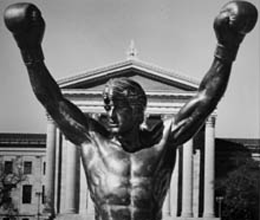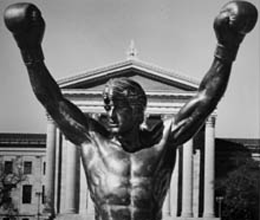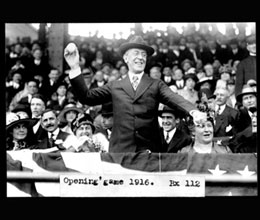Things We Can Learn from the Italian Stallion. Part 2.
 This is my blog post sequel covering the lessons we can learn from Rocky III and Rocky IV. For the first part see Things We Can Learn from the Italian Stallion.
This is my blog post sequel covering the lessons we can learn from Rocky III and Rocky IV. For the first part see Things We Can Learn from the Italian Stallion.
Rocky III
At the end of Rocky II, Rocky wins the title of heavyweight champion. He is now very wealthy and defends his title 10 times. In the beginning of Rocky III a real contender wants a piece of Rocky Balboa. His name…Clubber Lang.
Stay Hungry
Rocky has been living the good life for some years now beating up on has-beens and raking in the cash. When Clubber Lang comes along Rocky is not ready. While Clubber was training to win, Rocky had his training sessions at a hotel taking pictures with fans, selling merchandise and so on. He was doing everything, but training. Rocky was not hungry. He was the champ, what can stop him? Well, Clubber Lang stopped him. Rocky was not prepared and lost badly.
As a BA you always need to be prepared. Every initiative you work on is different. Just because you may have broad experience and a history of success you need to stay hungry.
Think of your next project as Clubber Lang. Always remember to be prepared and have the eye of the tiger! Your preparation is the act of developing a business analysis work plan. By having a plan for your work you will have a roadmap of where you are going and have thought through many of the issues that may pop-up during a project. Think about the characteristics of the people you’ll be working with. Some examples include each stakeholder’s preferred communication style, physical location, availability, and level of formality expected of your deliverables. Think about the characteristics of the project. Some examples include the type of project (COTS, new development, enhancements), the project priority, and how many interfaces are impacted by the project. Think about the processes you need to follow. Some things to consider are what methodologies are being used within your organization and what templates are used for deliverables.
Don’t be Afraid of Change
After Rocky’s loss to Clubber Lang, the great manager, Mickey Goldmill, died of a heart attack. In a bizarre turn of events Rocky went to train with his old rival Apollo Creed to take another stab at Clubber. In the first bout Apollo noticed how slow Rocky was and that he needed some quickness to avoid the thundering blows from Clubber. Apollo had Rocky focus on techniques that helped him move his feet. Initially Rocky was clumsy and struggling through these techniques. He was obviously frustrated. To try and motivate Rocky, Apollo tells him “it takes a real man to change.” That was one piece that helped Rocky excel to another level and eventually defeat Clubber Lang.
My new saying is “It takes a real BA to change”. I have said before we have to continuously learn and adapt to tackle the next project or situation. Yes, it will be frustrating at times, but the rewards are huge. Don’t be afraid to make mistakes. Those are the best learning opportunities. Use your community to share ideas and learn from others’ experiences. In Rocky III, Rocky trained with his old rival. Not that we have rival BAs, but don’t just talk with people that approach things like you do. Find people at your local IIBA chapter, online communities, or in your company that have a different style or take an alternative approach to situations.
Rocky IV
Rocky’s dethroning of Apollo Creed in Rocky II did not sit well with Apollo’s ego. He misses the limelight, and the cheers of the crowd. When the opportunity to get back into the public’s eye arose with a bout originally meant as an exhibition fight pitting Rocky against Russian super boxer, Ivan Drago, Apollo jumped at the chance to fight again. So Apollo signs up for a fight with Drago with Rocky in his corner.
Throw in the Towel
In the first round of the fight between Apollo and Drago, Drago pummels Apollo. At the end of the round Rocky says he needs to stop the fight. He pleads with Apollo to stop the fight, but Apollo tells Rocky “Don’t stop the fight…no matter what!” In round two Drago continued the pounding. Apollo’s wife and trainer were screaming to stop the fight. Rocky picked up the towel, but never threw it in the ring to stop the fight. With one more punch Drago killed Apollo.
As business analysts many of you may not work on life and death projects, but you have to know when to throw in the towel. In an earlier post, Get Your Head Out of the Weeds, I wrote about needing to get out of the detail and take a look at the bigger picture to make sure your efforts are still heading towards the goal of the project and company goals. If you see the project is off track, throw in the towel, because If the project is off track the direction of the project needs to be realigned or even stopped.
I recently spoke to a group of BAs about recommending a re-alignment or stopping the project. A response from the crowd indicated that doing that is a career ending move at his company. The reason being there are people at high levels that have personal reasons for seeing a project though even if it does not meet company goals.
My response to that comment is this is not an easy decision. But, if you don’t throw in the towel the company may not be alive for long. If enough bad decisions are made you may not have a job there anyway.
Kupe
Don’t forget to leave your comments below


 With spring comes Major League Baseball in the United States and Canada. With baseball comes tradition. One of the great traditions of baseball is the ceremonial first pitch. Before each game a guest throws a ball to a home team player to end the pregame festivities and mark the beginning of the game.
With spring comes Major League Baseball in the United States and Canada. With baseball comes tradition. One of the great traditions of baseball is the ceremonial first pitch. Before each game a guest throws a ball to a home team player to end the pregame festivities and mark the beginning of the game.
 When I began writing this blog series at BA Times last year, I aimed to focus on the behavioral characteristics of our role as business analysts. My goal was to go deeper than the science of our role and focus on the softer skills. I wanted to give you my thoughts and concrete ways to separate yourself from the pack of BAs by giving you ideas to up your game as a BA. After 10 months and 20 blog posts I have discovered the one thing, above all else, that is the pillar to your success as a business analyst That one thing is trust. The higher the trust relationships you have, the more success you can achieve.
When I began writing this blog series at BA Times last year, I aimed to focus on the behavioral characteristics of our role as business analysts. My goal was to go deeper than the science of our role and focus on the softer skills. I wanted to give you my thoughts and concrete ways to separate yourself from the pack of BAs by giving you ideas to up your game as a BA. After 10 months and 20 blog posts I have discovered the one thing, above all else, that is the pillar to your success as a business analyst That one thing is trust. The higher the trust relationships you have, the more success you can achieve.
 Last week I had lunch with a former co-worker to discuss an improvement plan she was implementing for a team of business analysts. I told her I would not reveal her name in this blog so let’s call her Wonder BA. Wonder BA is an active reader of this blog, so maybe she’ll chime in with a comment or two on this post and reveal herself. Wonder BA was recently promoted and given the responsibility to lead a BA improvement initiative. As we discussed her approach and things to consider with this initiative, I noticed the conversation did not focus on business analysis. There was little talk about an analysis process, how the BA role was used in their agile environment, or how to organize the BA group. The main focus was on the project team environment, how the team perceived the value of the BA, what their management team wanted to see more of from the BA community, and steps to roll out the BA improvements. It was all about ways to ensure this initiative or more specifically this change initiative would be accepted and adopted in Wonder BA’s organization. We talked about how to assess the change readiness of the organization and the individuals impacted; her thoughts on if the culture in her group was one that will accept and adopt the changes she wanted to implement, and how to motivate the individual BAs to embrace the change.
Last week I had lunch with a former co-worker to discuss an improvement plan she was implementing for a team of business analysts. I told her I would not reveal her name in this blog so let’s call her Wonder BA. Wonder BA is an active reader of this blog, so maybe she’ll chime in with a comment or two on this post and reveal herself. Wonder BA was recently promoted and given the responsibility to lead a BA improvement initiative. As we discussed her approach and things to consider with this initiative, I noticed the conversation did not focus on business analysis. There was little talk about an analysis process, how the BA role was used in their agile environment, or how to organize the BA group. The main focus was on the project team environment, how the team perceived the value of the BA, what their management team wanted to see more of from the BA community, and steps to roll out the BA improvements. It was all about ways to ensure this initiative or more specifically this change initiative would be accepted and adopted in Wonder BA’s organization. We talked about how to assess the change readiness of the organization and the individuals impacted; her thoughts on if the culture in her group was one that will accept and adopt the changes she wanted to implement, and how to motivate the individual BAs to embrace the change.